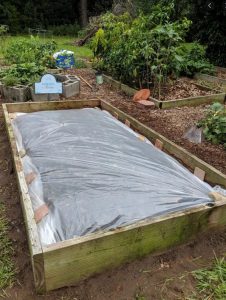North Florida vegetable gardeners have made it to summer and now the plants and gardeners are starting to give in to the heat and humidity. The squash has likely succumbed to squash vine borers, many of the tomato varieties are having trouble setting fruit, stink bugs are all over, and gardeners easily wilt by noon. This is a good time to use our oppressive heat to your advantage in the vegetable garden by solarizing the soil.

We have reached the peak of heat. Use it to your advantage in the garden. Source: National Weather Service.
Soil solarization is a method of pest control that creates a greenhouse to heat up the soil in an effort to drive away pests. Pests that can be reduced with soil solarization include weeds, various soil-borne fungal pathogens, and nematodes. Weed seeds can actually be killed by the increased temperatures, sometimes as high as 140 degrees Fahrenheit, while fungi and nematodes are merely driven deeper into the soil layer as they try to escape the heat. Although they are not killed, this can help vegetable gardeners as it may take these organisms 3-4 months to repopulate in high enough numbers to cause damage. Soil solarization can be considered another tool in your integrated pest management (IPM) toolbox, along with other cultural, physical, and chemical means of pest control.

A raised bed being solarized over the summer. Source: Evelyn Gonzalez, UF/IFAS Master Gardener Volunteer.
To properly execute soil solarization, the site should be in full sun and the existing vegetation removed, either by hand or with a tiller or other implement. Tilling can help loosen the soil surface and allow heat to penetrate deeper in the soil horizon. Before being covered with plastic, the area should receive rainfall or be irrigated, as the water will help conduct heat to greater depths. The next step is to cover the area with plastic. Note that this can also be done over raised beds! Clear plastic is best for maximum solar radiation penetration. Black plastic will heat up mostly on the surface and opaque plastic sheeting may not let enough light in to get temperatures high enough. The plastic should be slightly larger than the area covered, as the edges will need to be buried to create an air-tight seal. It’s recommended to leave the plastic in place for at least six to eight weeks, just in time to begin fall gardening preparations.
It’s important to monitor the site while it’s “cooking” to look for any holes that might appear. Small holes can be repaired with duct tape, while large holes or rips in the plastic may require starting over. Overlapping strips of plastic is not recommended since too much heat will be lost.
You may be wondering what happens to all of the good soil microbes. Well, unfortunately, they are also either killed or suppressed. Fortunately, researchers have found that they are able to repopulate quicker than the pest organisms, especially in soils with a good amount of organic matter.
Much more information on soil solarization can be found in these two documents:
Introduction to Soil Solarization – https://edis.ifas.ufl.edu/pdffiles/IN/IN85600.pdf
Solarization for Pest Management in Florida – http://edis.ifas.ufl.edu/pdffiles/IN/IN82400.pdf
Also, please contact your local county extension office for more gardening tips.
- When to Worry About Your Citrus During Cold Weather - December 18, 2025
- A Tale of Two Hoses - November 13, 2025
- Anthracnose and Aster Yellowing Diseases Recently Diagnosed - August 28, 2025
